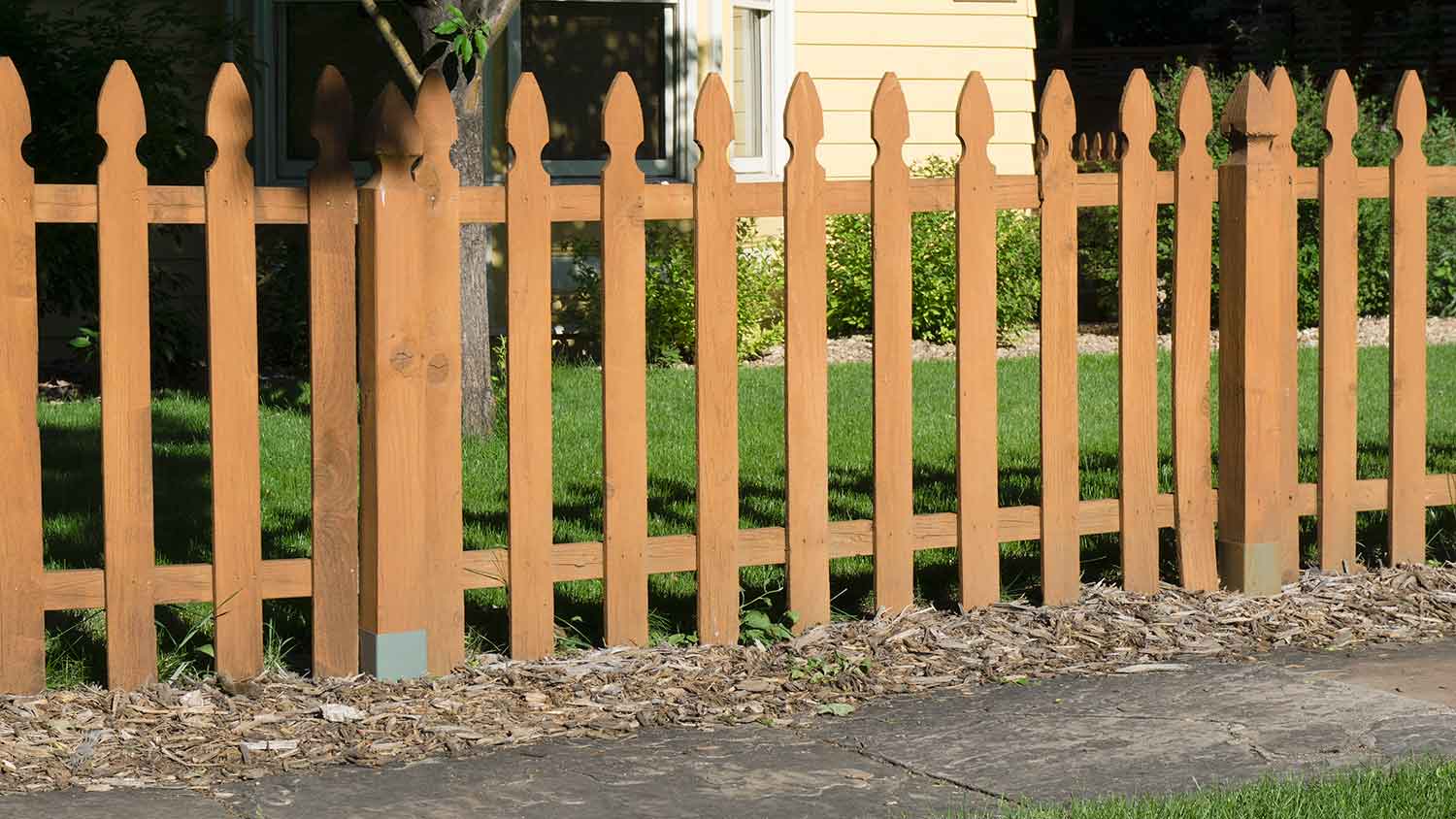8 Types of Metal Fences for Yards, Pools, and More
Forget about picket fences, nowadays it is all about metal


Metal fencing is popular for a few good reasons. Not only is metal reliable, but it’s also attractive, long-lasting, and exceptionally durable. However, choosing a metal fence over other materials is just your first decision, as there are many metal fence types to choose from, each with unique price points, advantages, and disadvantages.
Here is everything you have ever wanted to know about the various types of metal fencing so you’ll be prepared when it’s time to contact a local fence contractor for an estimate.
Wrought Iron Fences

This iconic fencing design is made by heating iron and forming it into various shapes. This type of fence has appeared on lawns for (literal) centuries and the manufacturing process allows for nearly limitless design options. Wrought iron costs around $26 to $34 per linear foot. The relatively high price here is due to the labor-intensive manufacturing process.
| Wrought Iron Fence Pros | Wrought Iron Fence Cons |
|---|---|
| Unique variety | Expensive material |
| Highly durable | Hard to install |
| Extremely secure | Prone to corrosion |
Pros
The strength of a wrought iron fence gives it several advantages over other types of metal.
Variety: Wrought iron does not refer to a shape or design, but rather the details of the manufacturing process. With that said, there are so many design options to choose from here, including ornamental designs, flat tops, arched tops, spearheads, and more.
Durability: Wrought iron fences take a licking and keep on ticking. As a matter of fact, they take thousands of lickings and keep on ticking. These fences are extraordinarily durable and long-lasting.
Increased security: It is extremely difficult to cut through wrought iron, so would-be interlopers will stay where they belong—off your property.
Cons
The construction of wrought iron fences is not without its drawbacks.
Susceptible to corrosion: Though extremely durable, wrought iron is susceptible to rust and corrosion, especially in coastal climates. Stave off these issues by regularly sealing, painting, or powder-coating your fence.
Pricier than some types: This is one of the more expensive types of metal fences, due to the manufacturing process.
Difficult to install: The installation process is also time-consuming and labor-intensive, further adding to your fence installation costs.
Cast Iron Fences
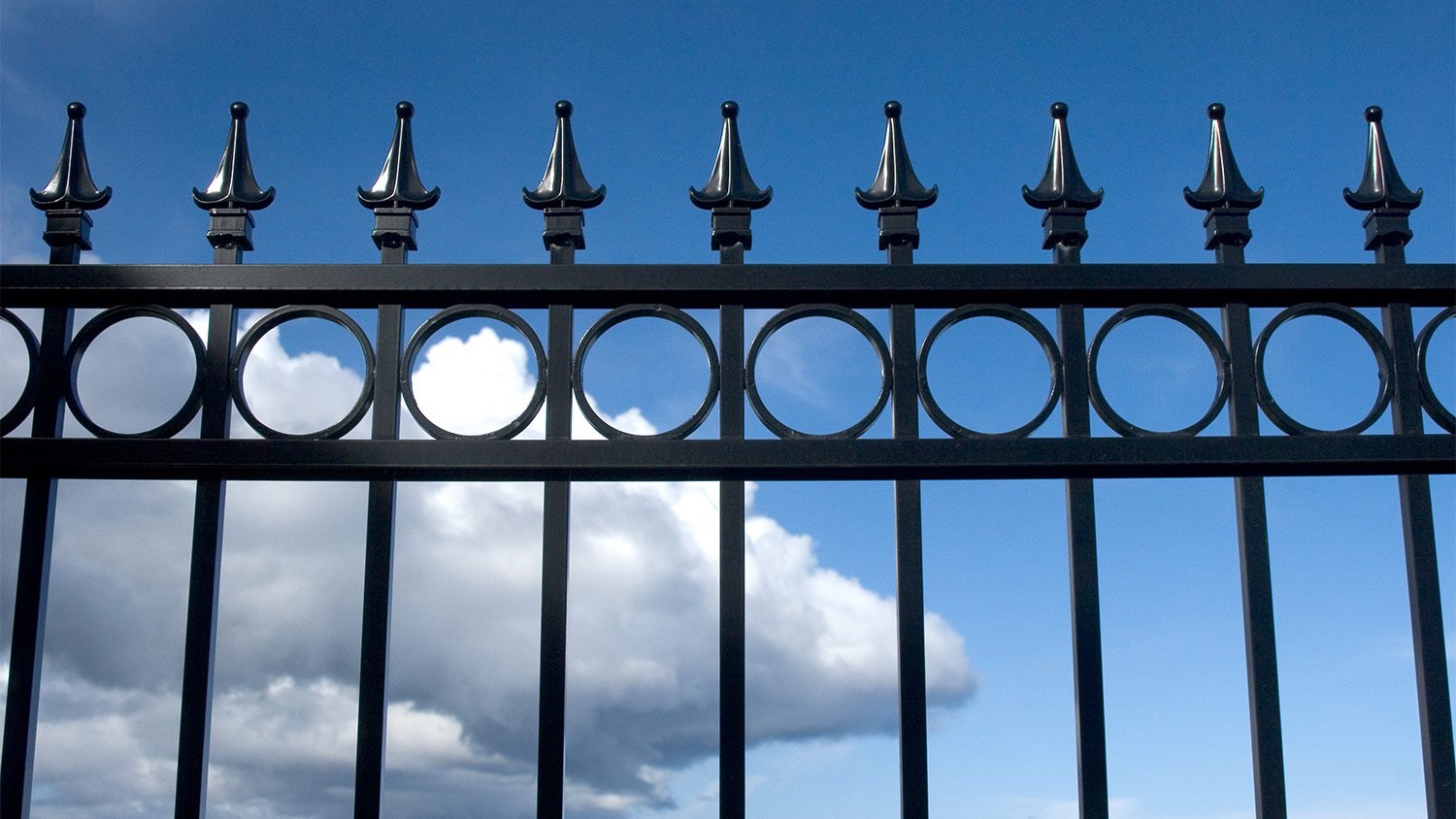
Cast iron fences are a budget-friendly alternative to wrought iron, as the metal is poured into a mold instead of being shaped manually with tools. This simplifies the installation process and lowers the overall price to around $16 to $24 per linear foot. Just like wrought iron, this fence type is available in multiple designs to suit a wide range of consumers, whether you want a more traditional black iron fence or a modern-looking fence in a brighter tone. Cast iron lasts a long time with proper maintenance and care, though it is susceptible to a wider range of environmental issues than wrought iron.
| Cast Iron Fence Pros | Cast Iron Fence Cons |
|---|---|
| Inexpensive material | Less secure |
| Multiple design options | Prone to rusting |
| Highly durable | Hard to install |
Pros
This more modern fencing material is popular for several reasons.
Budget-friendly: If wrought iron is just out of your price range, but you love the look, go with cast iron instead.
Diverse designs: Just like wrought iron, there are many designs and shapes to choose from.
Durable: Though cast iron flakes and rusts over time, the frame itself is nearly as durable as wrought iron.
Cons
Along with modern advantages, cast iron fences bring a few drawbacks.
Brittle: Cast iron is more brittle than wrought iron, so it does not stand up to quite the same level of pressure. In other words, it is slightly easier for would-be burglars to break it with the right tools.
Flakes and rusts: This metal type is susceptible to flaking, rusting, and peeling with enough time and extreme weather events.
Difficult to install: One thing it has in common with its wrought cousin is a labor-intensive installation process. These fences are heavy and bulky.
Aluminum Fences

Aluminum is naturally resistant to rust, making these fences the perfect choice to place around a pool or in coastal areas with plenty of moisture in the air. Aluminum fences are lightweight and more inexpensive than wrought iron fences, though adding specialized powder coatings and unique colors significantly increases the overall price. Aluminum fences cost $19 to $76 per linear foot, with the higher price ranges reserved for slat designs that require more materials. Picket-style designs with a top rail and bottom rail fall on the lower end of that price range.
| Aluminum Fence Pros | Aluminum Fence Cons |
|---|---|
| Weather-resistant material | Less secure |
| Several color options | Not durable |
| Low-maintenance | Large gaps |
Pros
Aluminum’s rust-resistant properties aren’t its only advantages.
Weather resistance: Aluminum naturally resists rust and corrosion, so these fences shrug off extreme weather conditions with ease.
Various colors: Most aluminum fences are powder-coated and these coatings are available in many colors to suit the needs of different consumers.
Reduced maintenance needs: Aluminum’s natural tendency to reduce many weather-related issues makes it a low-maintenance fence. Hire a local aluminum fence contractor yearly for a simple inspection.
Cons
Despite its strength against weathering, aluminum lacks in certain areas.
Decreased security: Many aluminum fences are installed with simple screws, so it is relatively easy to unscrew the fence and enter your property.
Gaps on the larger side: Though designs differ, the gaps between each aluminum rung tend to be on the larger side, making it easy for pets to escape the property. However, you can install puppy pickets to make these gaps smaller.
Decreased durability: Though resistant to rust and corrosion, aluminum bends when hit with objects like pieces of storm debris. Higher-grade aluminum decreases this risk, but this option increases the cost.
Steel Fences

Steel fences are a good substitute for wrought iron, as it is available in similar styles at a reduced cost. As a matter of fact, many manufacturers advertise something as wrought iron when it is actually steel, so read the fine print before settling on a purchase. Steel fences are welded together or joined with rivets, and the material is highly resistant to rust. Standard steel does not resist corrosion, but galvanized steel does. Steel fences cost anywhere from $23 to $45 per linear foot.
| Steel Fence Pros | Steel Fence Cons |
|---|---|
| Rust-resistant | Hard to install |
| Several design options | Prone to scratching |
| Better security | Less privacy |
Pros
Though not as high-end as wrought iron, steel fencing still offers several benefits.
Resists rust: Standard steel resists rust, making it a great choice for moisture-heavy environments. Going a step further to galvanized steel also resists corrosion.
Many design options: Galvanized steel is not your potential add-on here, as there are many design options to choose from, such as prefabricated steel panels, corten steel, and more.
Increased security: Steel fences are manufactured by welding pieces together, so there are no screws. In other words, this is a highly secure metal type that is not easily dismantled.
Cons
Steel may be less expensive than other metals, but that affordability has a few drawbacks.
Installation difficulty: Here is another thing steel has in common with wrought iron. It is extremely heavy, bulky, and difficult to install. This makes it a less-than-ideal option for DIYers.
Not scratch-resistant: Though resistant to rust and corrosion (with galvanized steel,) this metal is not resistant to scratches. Over time, these imperfections add up.
Not much privacy: The gaps between steel fences tend to be on the larger side, decreasing privacy. Solid panels are an option here, but that significantly increases the cost.
Chain-Link Fences
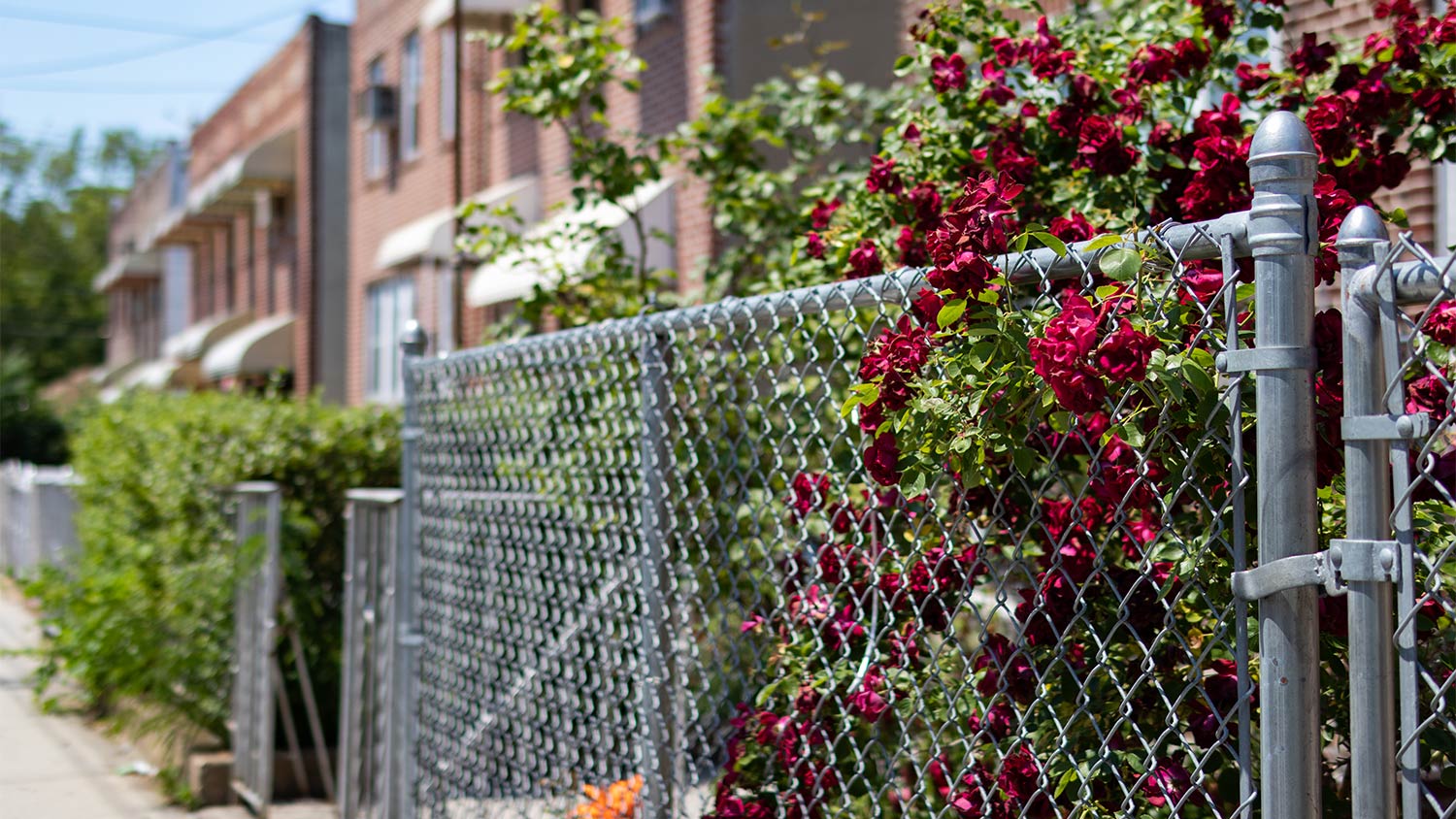
The humble chain-link fence is a tried-and-true method for fencing in your property because they’re affordable, practical, and easy to install. Chain link fences cost $12 to $33 per linear foot and are especially popular among pet owners, as there are no gaps large enough for cats or dogs to squeeze through. The chain links are available in many different materials, including galvanized steel, stainless steel, and aluminum.
Not everyone is a fan of the chain-link aesthetic, but black chain-link fences are a more eye-pleasing option. This style of chain-link fence comes wrapped in vinyl material.
| Chain Link Fence Pros | Chain Link Fence Cons |
|---|---|
| Less expensive material | Less privacy |
| Design and color options | Not eye-pleasing |
| Easy to install | Less security |
Pros
Though it’s on the more basic side of metal fencing, chain-link offers many advantages.
Budget-friendly: The price is right here, particularly if you are just looking for something simple that gets the job done.
Color and design variety: Chain links integrate nicely with vinyl coatings, allowing for a multitude of color and design options.
Easy to install: Installing chain link fences is easy because they are on the lighter side. DIYers, take note.
Cons
As you might expect, the humble chain-link fence doesn’t excel in all areas.
Reduced aesthetics: Metal fences are known for increasing property value, but this ROI does not extend to chain-link fences. The aesthetics here are practical, but barebones.
Security concerns: Though chain links do a great job at keeping pets and children in, they are not so great for keeping intruders out. Nefarious would-be thieves can easily climb over it or cut through it. Barbed wire fencing on top is an option here, but it is illegal in many areas—not to mention unsightly.
Limited privacy: The gaps between chain links allow neighbors and passersby to easily see what you are up to, though installing slats is an option.
Wire Fences
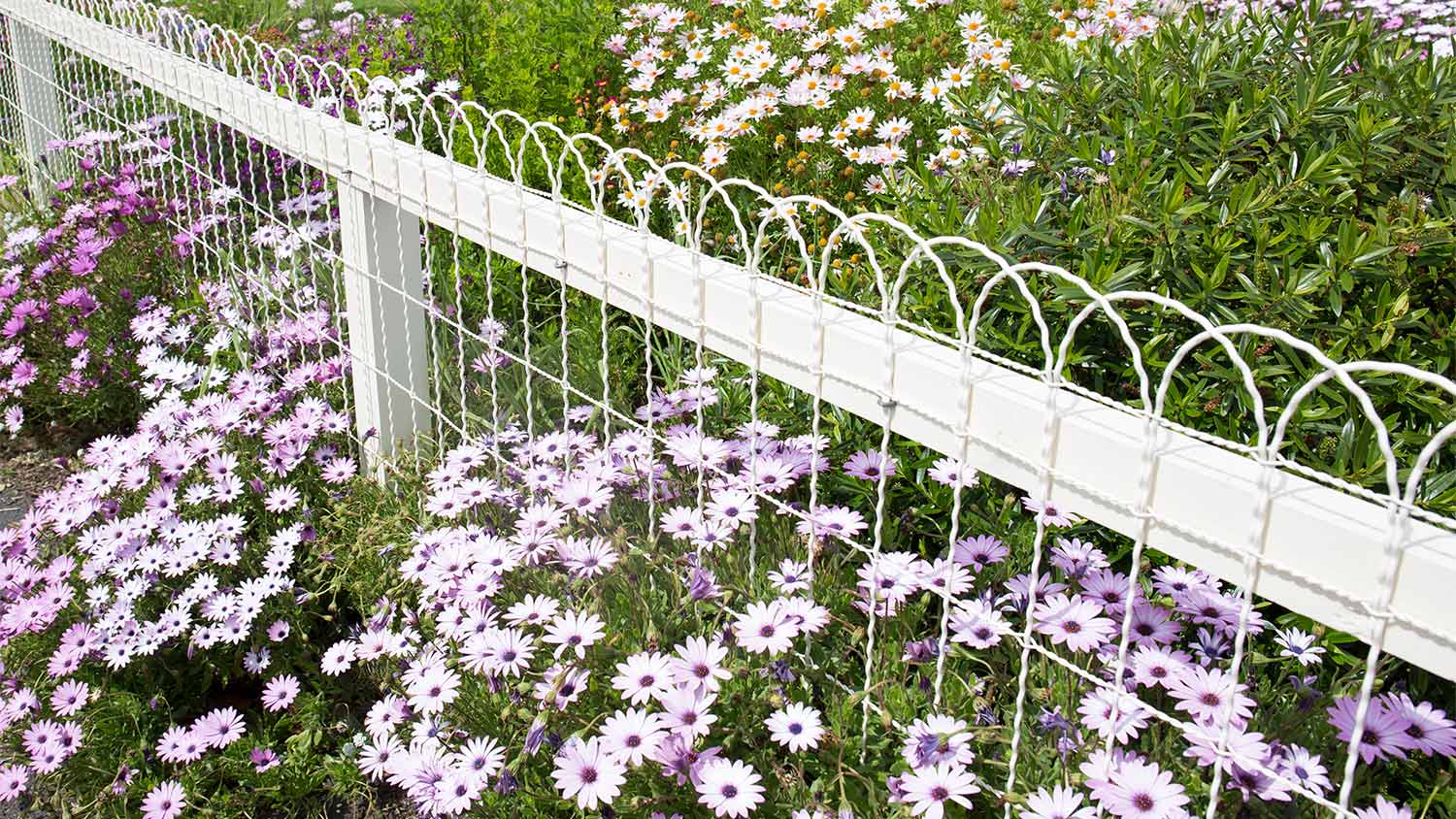
Looking for an even more budget-friendly option than a chain-link fence? Go for a wire fence. This is the most affordable option among metal fences, with the cost to install a wire fence sitting at just $3 to $5 per linear foot. It does a good job at keeping animals in or out and at drawing a perimeter around parts of your property like gardens. Wire fences range in styles from simple wires strung between posts to wire mesh stuffed into frames. Other types include chicken wire, hog wire, barbed wire, razor wire, and wire mesh, the last of which is often used for snow fencing.
| Wire Fence Pros | Wire Fence Cons |
|---|---|
| Easy installation | Not eye-pleasing |
| Easy to repair | Sometimes restricted |
| Good value | Not secure |
Pros
Wire is the most affordable type of metal fencing, but that’s not the only advantage it offers.
Easy to install: Wire is even lighter than chain-link fences, making for a quick and easy install for both pros and amateurs.
Quick repairs: Just as these fences are easy to install, they are easy to repair, even by yourself. Wire fences are repaired with a simple soldering iron or by replacing a small section.
Bang for your buck: If you just want a fence, any fence, on your property and your budget is tight, this is the go-to option.
Cons
If you’re interested in wire fencing, keep in mind that it may bring a few problems along with it.
Unattractive: Wire fences are not going to win any aesthetics awards, though adding a wooden frame boosts the visual appeal.
Some types not allowed: Not all residential areas allow certain types of wire fences, such as barbed wire and hog wire. Check with your local regulatory agencies to be sure.
Easy to cut through: Wire fences are easy to fix, but they are also easy to break, particularly if you are cutting through it on purpose to trespass.
Corrugated Metal Fences

If you’re looking for a privacy fence that also offers security, go for a corrugated metal fence. These DIY-friendly fences are easy to install, completely private, and resistant to rust, as most corrugated metal panels list galvanized steel as a key material. Corrugated metal fences cost $7 to $13 per linear foot. Many homeowners combine this type of fence with more traditional materials, such as wood or aluminum pickets, to block out a portion of the property from unwanted sightseers.
| Corrugated Metal Fence Pros | Corrugated Metal Fence Cons |
|---|---|
| Sustainable option | Sharp edges |
| Easy to install | Causes echoes |
| Good privacy | Limited design options |
Pros
There are several reasons one might consider adding a corrugated metal fence to their property.
Eco-friendly: The vast majority of corrugated metal panels are recyclable, making this an environmentally friendly option.
Easy to install: These corrugated panels are made from a variety of metals and related compounds and are surprisingly light, making them appropriate for a DIY installation.
Total privacy: These are solid panels, so peepers and creepers are totally out of luck.
Cons
Installing corrugated metal fencing also has its disadvantages.
Possible sharp edges: Many corrugated metal panels have sharp edges, making them potentially dangerous for children. Additionally, sharp edges can develop over time.
Not the best acoustics: Surrounding your entire perimeter with a corrugated metal fence impacts the acoustics, leading to increased echoes as soundwaves bounce off the panels.
Limited color and design options: There is not much variety on offer here, and these panels are not exactly visually appealing. Still, painting and cutting them to suit differing tastes is possible.
Metal Privacy Screens

If the primary reason you want a fence is to make your backyard feel a little more intimate, a metal privacy screen might be what you're looking for. These fences are usually just decorative, with intricate cutouts that cleverly let light through without giving the neighbors too much of a view. Expect the materials and intricate designs to cost an average of $31 per linear foot.
Unless you hire a pro to install your privacy screen, it'll likely be rooted in the ground with simple stand poles that aren't suited to security. That said, there are many ways to incorporate privacy fences and create a safe, secluded oasis in your outdoor space.
| Metal Privacy Screen Pros | Metal Privacy Screen Cons |
|---|---|
| Eye-pleasing | Expensive |
| Good privacy | Not secure |
Pros
Metal privacy screens offer some key benefits that help them serve a very specific purpose.
Aesthetically pleasing: Privacy screen designs often include intricate shapes that help emphasize the beauty of small backyard spaces.
Privacy: It goes without saying that a privacy screen can make your backyard feel more secluded and peaceful.
Let the light in: The cutout designs of a privacy screen offer just enough light without letting prying eyes see into your yard.
Cons
Because they're so highly specific in use, privacy screens aren't right for everyone.
High cost: The high-end materials and intricate designs used for privacy screens significantly increase their cost.
Low security: Most privacy fences aren't firmly rooted in the ground, providing more aesthetics than backyard security.
What to Consider When Choosing the Right Metal Fence for You
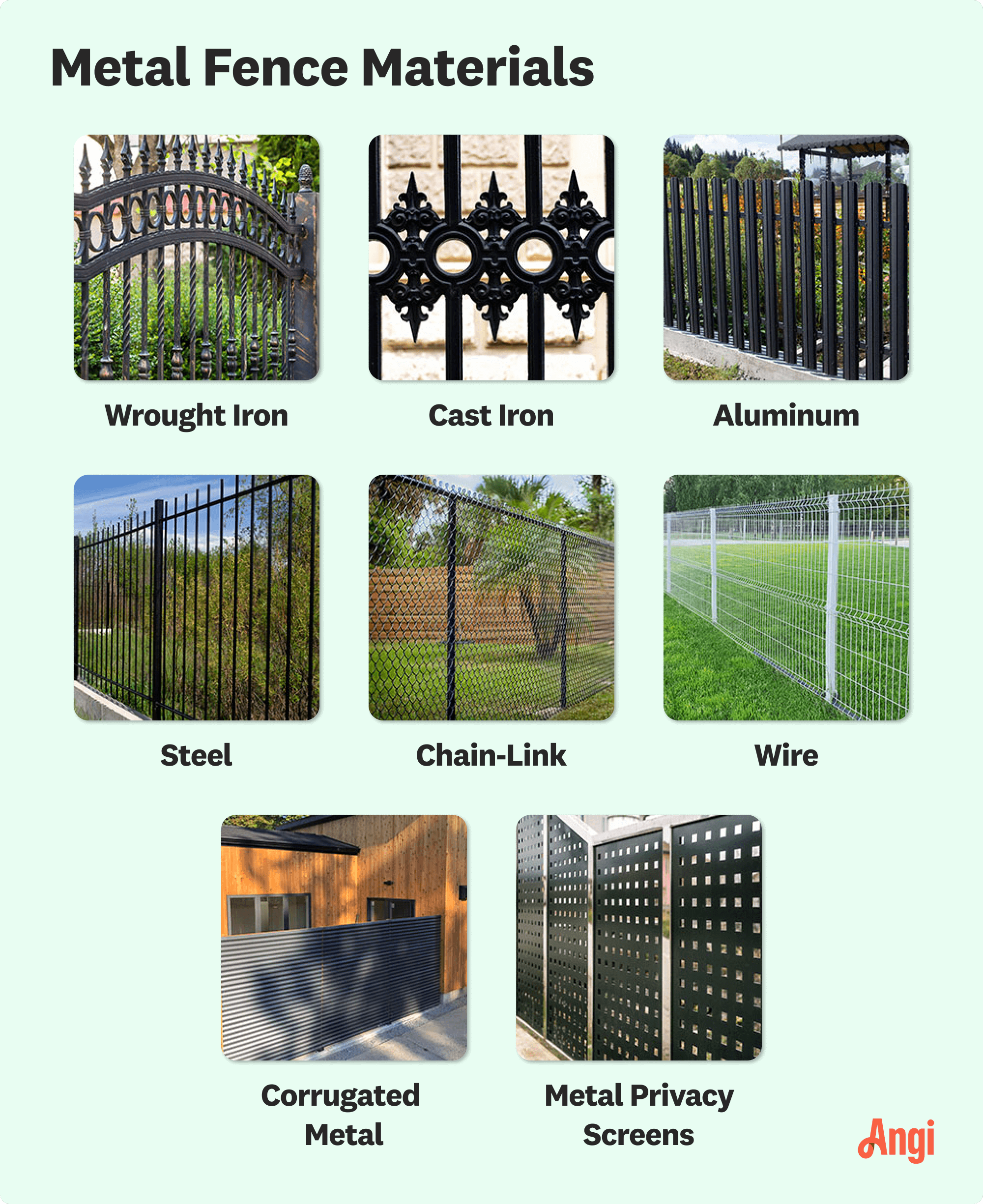
When picking the perfect metal fence for your space, it’s all about balancing a few key things — things like cost, durability, and how much effort you’re willing to put into maintenance. Fence installation prices can vary a lot, as little as $3 per linear foot for wire fencing and up to $76 per linear foot for sleek aluminum. You can definitely save a few bucks by installing a metal fence yourself, but some fences are heavy-duty, complex, and better left to professionals. While strong materials like steel or wrought iron can really stand the test of time, they do require a bit more TLC, especially when it comes to preventing rust. Additionally, different metals offer varying levels of security, privacy, and curb appeal, so it’s worth thinking about what fits best with what you need — both now and down the road.
Considerations:
Cost: Wire fences are the cheapest, with steel, aluminum, and wrought iron being the most expensive.
Installation: DIY is possible with simpler fences like wire and chain link, but metal options like steel and aluminum require heavy lifting, precise measurements, and professional help.
Durability: Wrought iron and steel last long but need maintenance to prevent rust while aluminum is rust-proof but more fragile. Chain link and corrugated fences are among the most durable.
Security and privacy: Wrought iron and steel offer strong security but limited privacy. Corrugated metal provides both, while chain link, aluminum, and wire offer limited security and no privacy.
Maintenance: Steel and wrought iron are two of the strongest types of fencing, but they need regular repainting to prevent rust. Aluminum and corrugated fences are rust-proof and, therefore, need less maintenance.
Aesthetic: Wrought iron, aluminum, and steel are stylish with lots of design options while chain link and wire are more industrial-looking, and won’t help your curb appeal. Corrugated fencing offers a modern look, especially when combined with wood elements.
Frequently Asked Questions
The most common type of metal fence today is one made of either steel or aluminum. These materials are relatively easy to fabricate, making them much more cost-effective than traditional metal fencing handmade from wrought iron. They’re also much lighter and easier to install, contributing to their affordability and making them more DIY-friendly.
The most affordable metal fence type is wire at just $3 to $5 per linear foot. Wire fences come in a variety of styles and do a good job of marking perimeters and keeping animals in or out of certain areas. While they’re very easy to install and repair, many homeowners find them unattractive, and many homeowners associations won’t allow them.
The most durable metal for a fence is wrought iron. With proper care, a wrought iron fence can last for centuries. This means regular resealing to stave off rust and corrosion, especially in coastal climates with salty sea air. In these environments, chain link and corrugated fencing tend to stand up better to the elements with fewer maintenance needs.





- 11 Types of Fences for Added Privacy in Your Yard
- 8 Best Fences for Dogs: Pros and Cons of Every Option
- 6 Tips for Choosing the Best Fence for Your Yard
- Chain Link Fence vs. Wood Fence: Pros, Cons, Costs
- The Best Low-Maintenance Fence Options for Your Home
- The Pros and Cons of Vinyl Fencing—Is There a Preference for PVC?
- 30 Front Yard Fence Ideas to Welcome You Home
- 5 Best Types of Chain Link Fences: Which Is Right for You?
- 16 Excellent Privacy Fence Ideas for Your Outdoor Space
- Deer Fencing for Gardens: 7 Ways to Keep Deer Out of Your Garden



